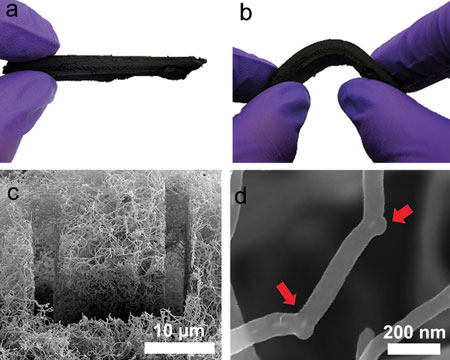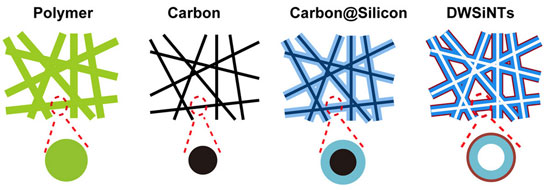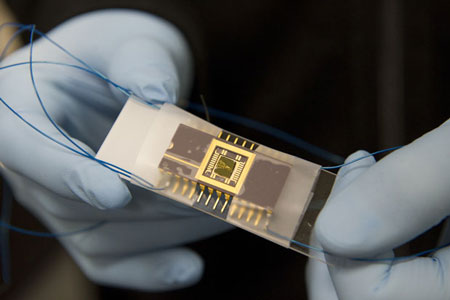Using light-harvesting nanoparticles to convert laser energy into "plasmonic nanobubbles", researchers are developing new methods to inject drugs and genetic payloads directly into cancer cells. In tests on drug-resistant cancer cells, the researchers found that delivering chemotherapy drugs with nanobubbles was up to 30 times more deadly to cancer cells than traditional drug treatment and required less than one-tenth the clinical dose.
May 11th, 2012
Read more
A new type of implant developed by researchers at Brown University may be able to deter breast cancer cell regrowth. Made from a common federally approved polymer, the implant is the first to be modified at the nanoscale in a way that causes a reduction in the blood-vessel architecture that breast cancer tumors depend upon, while also attracting healthy cells into breast tissue.
May 11th, 2012
Read more
A team of investigators from the Northwestern University Center for Cancer Nanotechnology Excellence (Northwestern CCNE) has developed a rapid, array-based technology using gold nanoparticles that is capable of detecting miRNAs at levels as low as 1 femtomolar (about 30,000 molecules in a drop of blood).
May 11th, 2012
Read more
Drugs made of protein have shown promise in treating cancer, but they are difficult to deliver because the body usually breaks down proteins before they reach their destination. To get around that obstacle, a team of researchers has developed a new type of nanoparticle that can synthesize proteins on demand. Once these "protein-factory" particles reach their targets, the researchers can turn on protein synthesis by shining ultraviolet light on them.
May 11th, 2012
Read more
While a great deal of the potential for nanotechnology to improve cancer therapy lies with the ability of nanoparticles to deliver drug payloads directly to tumors, an equally important consideration is whether nanoparticles can then get their drug payload to their intended target inside tumor cells. Now, a team of investigators has developed star-shaped nanoparticle that can deliver a drug directly to a cancer cell's nucleus - an important feature for many potential anticancer therapies.
May 11th, 2012
Read more
 A carbon nanotube sponge that can soak up oil in water with unparalleled efficiency has been developed with help from computational simulations performed at the Department of Energy's Oak Ridge National Laboratory.
A carbon nanotube sponge that can soak up oil in water with unparalleled efficiency has been developed with help from computational simulations performed at the Department of Energy's Oak Ridge National Laboratory.
May 10th, 2012
Read more
A hidden facet of a math problem that goes back to Sanskrit scrolls has just been exposed by nanotechnology researchers at the University of Michigan and the University of Connecticut.
May 10th, 2012
Read more
The California Nanosafety Consortium of Higher Education has published "Nanotoolkit - Working Safely with Engineered Nanomaterials in Academic Research Settings", a compendium of best practices, standards, and guidelines to using engineered nanomaterials.
May 10th, 2012
Read more
Researchers at the University of Turku believe that flexible, lightweight and inexpensive dyes could be used to harvest the power of the sun rather than our relying on costly and fragile semiconductor solar panel that use crystalline silicon.
May 10th, 2012
Read more
 For more than a decade, scientists have tried to improve lithium-based batteries by replacing the graphite in one terminal with silicon, which can store 10 times more charge. But after just a few charge/discharge cycles, the silicon structure would crack and crumble, rendering the battery useless. Now a team led by materials scientist Yi Cui of Stanford and SLAC has found a solution: a cleverly designed double-walled nanostructure that lasts more than 6,000 cycles, far more than needed by electric vehicles or mobile electronics.
For more than a decade, scientists have tried to improve lithium-based batteries by replacing the graphite in one terminal with silicon, which can store 10 times more charge. But after just a few charge/discharge cycles, the silicon structure would crack and crumble, rendering the battery useless. Now a team led by materials scientist Yi Cui of Stanford and SLAC has found a solution: a cleverly designed double-walled nanostructure that lasts more than 6,000 cycles, far more than needed by electric vehicles or mobile electronics.
May 10th, 2012
Read more
Better than antibiotics, it is being used in contact lenses to prevent infections and biomedical products are the next stage.
May 10th, 2012
Read more
 Researchers at Norteastern University have received a three-year, $309,000 National Science Foundation grant to explore a phenomenon they discovered entirely by chance, which could afford a new generation of extremely efficient electronics.
Researchers at Norteastern University have received a three-year, $309,000 National Science Foundation grant to explore a phenomenon they discovered entirely by chance, which could afford a new generation of extremely efficient electronics.
May 10th, 2012
Read more
Chemists and physicists are collaborating within a new research group at the University of Wuerzburg. Their stated objective is to enable the manufacture of new materials with customized properties. The German Research Foundation (DFG) is funding the project.
May 10th, 2012
Read more
The Gold Scientist Prize programme has been established by the World Gold Council to recognise outstanding gold-based research performed by early-career scientists. Work eligible for consideration can be on-going studies, research completed in the last twelve months or a body of work compiled over several years in any materials science or related discipline where gold is central to the research.
May 10th, 2012
Read more
Krankheitserreger im Trinkwasser sind in den Entwicklungslaendern, aber auch in Deutschland, z. B. im Rahmen von Sanierungsvorhaben, oft ein grosses Problem. Deshalb spielt das Thema beim IPHT-Symposium "DNA-Nano-Sensors" vom 10. - 12.5. eine grosse Rolle.
May 10th, 2012
Read more
Light-emitting diodes at infrared wavelengths are the magic behind such things as night vision and optical communications, including the streaming data that comes through Netflix. Cornell researchers have advanced the process of making such LEDs cheaper and easier to fabricate, which could lead to ultra-thin LEDs painted onto silicon to replace computer wiring with light waves.
May 10th, 2012
Read more




 Subscribe to our Nanotechnology News feed
Subscribe to our Nanotechnology News feed